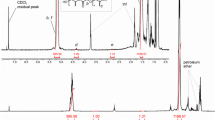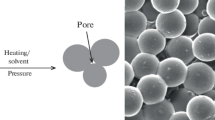Abstract
Bioresorbable polylactides are one of the most important materials for tissue engineering applications. In this work we have prepared scaffolds based on the two optically pure stereoisomers: poly(l-lactide) (PLLA) and poly(d-lactide) (PDLA). The crystalline structure and morphology were evaluated by DSC, AFM and X-ray diffraction. PLLA and PDLA crystallized in the α form and the equimolar PLLA/PDLA blend, crystallized in the stereocomplex form, were analyzed by a proliferation assay in contact with mouse L-929 and human fibroblasts and neonatal keratinocytes for in vitro cytotoxicity evaluation. SEM analysis was conducted to determine the cell morphology, spreading and adhesion when in contact with the different polymer surfaces. The preserved proliferation rate showed in MTT tests and the high colonization on the surface of polylactides observed by SEM denote that PLLA, PDLA and the equimolar PLLA/PDLA are useful biodegradable materials in which the crystalline characteristics can be tuned for specific biomedical applications.







Similar content being viewed by others
References
Langer R, Vacanti JP. Tissue engineering. Science. 1993;260:920–6.
Yang S, Leong K, Du Z, Chua C. The design of scaffolds for use in tissue engineering. Part I. Traditional factors. Tissue Eng. 2001;7:679–89.
Takezawa T. A strategy for the development of tissue engineering scaffolds that regulate cell behavior. Biomaterials. 2003;24:2267–75.
Salgado AJ, Coutinho OP, Reis RL. Novel starch-based scaffolds for bone tissue engineering: cytotoxicity, cell culture, and protein expression. Tissue Eng. 2004;10:465–74.
Thomsom RC, Mikos AG, Beahm E, Lemon JC, Saterfield WC, Aufdemorte TB, Miller MJ. Guided tissue fabrication from periosteum using preformed biodegradable polymer scaffolds. Biomaterials. 1999;20:2007–18.
Navarro M, Ginebra MP, Planell JA, Zeppetelli S, Ambrosio L. Development and cell response of a new biodegradable composite scaffold for guided bone regeneration. J Mater Sci Mater Med. 2004;15:419–22.
Ren J, Ren T, Zhao P, Huang Y, Pan K. Repair of mandibular defects using MSCs-seeded biodegradable polyester porous scaffolds. J Biomater Sci Polym Ed. 2007;18:505–17.
Wang S, Cui W, Bei J. Bulk and surface modifications of polylactide. Anal Bioanal Chem. 2005;381:547–56.
Reis RL, Cunha AM. Starch and starch based thermoplastics. Biological and biomimetic materials. Amsterdam: Pergamon-Elsevier Science; 2001. p. 8810–6.
Vainionpaa S, Rokkanen P, Tormala P. Surgical applications of biodegradable polymers in human tissues. Prog Polym Sci. 1989;14:679–716.
De Jong WH, Eelco Bergsma J, Robinson JE, Bos RM. Tissue response to partially in vitro predegraded poly-L-lactide implants. Biomaterials. 2005;26:1781–91.
Okamoto Y. “Trends in polymer science” chiral polymers. Prog Polym Sci. 2000;25:159–62.
Sarasua JR, Prud’homme RE, Wisniewski M, LeBorgne A, Spassky N. Crystallization and melting behaviour of polylactides. Macromolecules. 1998;31:3895–905.
Södergard A, Stolt M. Properties of lactic acid based copolymers, their correlation with composition. Prog Polym Sci. 2002;27:1123–63.
De Santis P, Kovacs AJ. Molecular conformation of poly(S-lactid acid). Biopolymers. 1968;6:299–306.
Okihara T, Tsuji M, Kawaguchi A, Katayama K, Tsuji H, Hion H, Ikada Y. Crystal structure of stereocomplex of poly(L-lactide) and poly(D-lactide). J Macromol Sci B. 1991;30:119–40.
Ikada Y, Jamshidi K, Tsuji H, Hyon SH. Stereocomplex formation between enantiomeric poly(lactides). Macromolecules. 1987;20:904–6.
Brizzolara D, Cantow HJ, Diedericks K, Seller E, Domb J. Mechanism of the stereocomplex formation between enantiomeric poly(lactides)s. Macromolecules. 1996;29:191–7.
Sarasua JR, López-Rodríguez N, López-Arraiza A, Meaurio E. Stereoselective crystallization and specific interactions in polylactides. Macromolecules. 2005;38:8362–71.
Sarasua JR, López-Arraiza A, Balerdi P, Maiza I. Crystallization, thermal behaviour of optically pure polylactides, their blends. J Mater Sci. 2005;40:1855–62.
Sarasua JR, López-Arraiza A, Balerdi P, Maiza I. Crystallization, mechanical properties of optically pure polylactides, their blends. Polym Eng Sci. 2005;45:745–53.
Li S, McCarthy S. Further investigations on the hydrolytic degradation of poly(DL-lactide). Biomaterials. 1999;201:35–44.
Tsuji H, Miyauchi S. Poly(L-lactide): VI effects of crystallinity on enzymatic hydrolysis of poly(L-lactide) without free amorphous region. Polym Degrad Stabil. 2001;71:415–24.
Tsuji H. In vitro hydrolysis of blends from enantiomeric poly(lactide)s. Biomaterials. 2003;24:537–47.
Karst D, Yang Y. Molecular modelling study of the resistance of PLA to hydrolysis based on the blending of PLLA and PDLA. Polymer. 2006;47:4845–50.
Bernal-Lara TE, Liu RF, Hiltner A, Baer E. Structure and thermal stability of polyethylene nanolayers. Polymer. 2005;46:3043–55.
Kikkawa Y, Abe H, Fujita M, Iwata T, Inoue Y, Dói Y. Crystal growth in poly(L-lactide) thin film revealed by in situ atomic force microscopy. Macromol Chem Phys. 2003;204:1822–31.
Meaurio E, López-Rodríguez N, Sarasua JR. Infrared spectrum of poly(L-lactide): application to crystallinity studies. Macromolecules. 2006;39:9291–301.
Fischer EW, Stertzel HJ, Wegner G. Investigation of the structure of solution grown crystals of lactide copolymers by means of chemicals reactions. Kolloid Z Z Polym. 1973;251:980–90.
Nakagawa M, Teraoka F, Fujimoto S, Hamada Y, Kibayashi H, Takahashi J. Improvement of cell adhesion on poly(L-lactide) by atmospheric plasma treatment. J Biomed Mater Res B. 2006;77:112–8.
Yamaguchi M, Shinbo T, Kanamori T, Wang PC, Niwa M, Kawakami H, Nagaoka S, Hirakawa K, Kamiya M. Surface modification of poly(L-lactic acid) affects initial cell attachment cell morphology, and cell growth. J Artif Organs. 2004;7:187–93.
Park A, Cima LG. In vitro cell response to differences in poly(L-lactide) crystallinity. J Biomed Mater Res B. 1996;31:117–30.
Biggs DL, Lengsfeld CS, Hybertson BM, Ka-yun NG, Manning MC, Randolph TW. In vitro, in vivo evaluation of the effects of PLA microparticle crystallinity on cellular response. J Control Release. 2003;92:147–61.
Lee J, Cuddihy MJ, Kotov NA. Three-dimensional cell culture matrices: state of the art. Tissue Eng Part B. 2008;14:61–86.
Yi Q, Xintao W, Li L, He B, Nie Y, Wu Y, Zhang Z, Gu Z. The chiral effects on the responses of osteoblastic cells to the polymeric substrates. Eur Polym J. 2009;45:1970–8.
ISO document 10993-12 Biological compatibility of medical devices. Sample Preparation and Reference Materials 1992.
ISO document 10993-5 Biological compatibility of medical devices. Test for cytotoxicity: in vitro methods. 1992.
Chen H, Cebe P. Investigation of the rigid amorphous fraction in Nylon-6. J Therm Anal Calorim. 2007;89:417–25.
Ohtani Y, Okumura K, Kawaguchi A. Crystallization behavior of amorphous poly(L-lactide). J Macromol Sci B. 2003;42:875–88.
Sperling LH. Introduction to physical polymer science. New York: Wiley; 1992.
Pan P, Inoue Y. Polymorphism and isomorphism in biodegradable polyesters. Prog Polym Sci. 2009;34:605–40.
Acknowledgments
The authors are thankful for financial support from the Basque Government Department of Education, University and Research (consolidated research groups GIC10/152-IT-334-10 and project IT431-07) and Department of Health (PI2005111043). We also thank SGIKER from UPV/EHU for WAXD and SEM measurements and the support of CIC Biomagune and Biobasque agency (Project Etortek IE07-201).
Author information
Authors and Affiliations
Corresponding author
Rights and permissions
About this article
Cite this article
Sarasua, J.R., López-Rodríguez, N., Zuza, E. et al. Crystallinity assessment and in vitro cytotoxicity of polylactide scaffolds for biomedical applications. J Mater Sci: Mater Med 22, 2513–2523 (2011). https://doi.org/10.1007/s10856-011-4425-1
Received:
Accepted:
Published:
Issue Date:
DOI: https://doi.org/10.1007/s10856-011-4425-1




